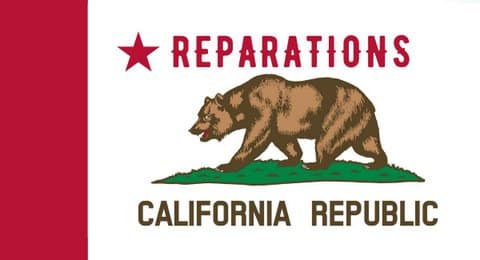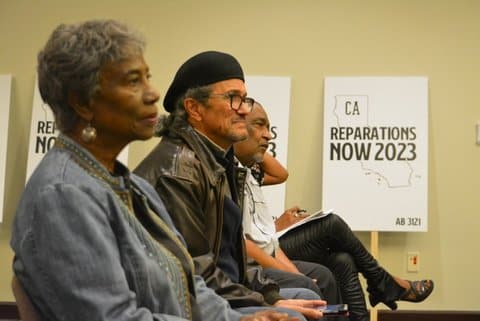
03 Mar California Steps Up on Long March to Reparations

By Mark Hedin, Ethnic Media Services
The “free state” of California never formally embraced slavery, but slavery and racist policies that derived from it helped make California what it is today – the nation’s wealthiest state, and the world’s fifth-largest economy.
“California encouraged slavery, it profited from slavery. Not only slavery, but post-slavery activities that took place – redlining, vicious attacks, stealing people’s property,” Secretary of State Shirley Weber said at a Feb. 28 press briefing.
But while serving as a member of the state Assembly representing San Diego, Weber authored AB 3121, which in 2021 established the nation’s first governmental study of how to help heal those injuries.
At the briefing, hosted by California Black Media and Ethnic Media Services, Weber and two of the resulting nine-member California Reparations Task Force discussed its work.
Its recommendations will be released on July 1.
“AB 3121 came out of the fact that we could not pass a bill out of Washington,” Weber said. “Congress has been grappling with the issue of reparations for 40 years now, and in each case, it doesn’t seem to get off the floor.”
She continued, “Given the number of efforts that have been made to do this, California could be an example of what can possibly happen.”
Also at the briefing were Assemblyman Reggie Jones-Sawyer, from Los Angeles, and lawyer Don Tamaki, whose pro-bono work led in 1988 to reparations for Japanese American internees of World War II, and the voiding and eventual overruling of Korematsu v. United States (1942).
Reparations are not a silver bullet
Jones-Sawyer began by naming his colleagues on the panel and the extensive preliminary report they produced last year.
“People keep talking about reparations in the form of financial remuneration and compensation,” Jones-Sawyer said. “But this will not be a one-and-done silver bullet… We’re going to have to do several things to be able to bring African Americans up to the same standard as others.”
He mentioned improving access to capital to develop the business community and the generational wealth that accrues from property ownership, confronting separate and unequal education, “which is probably the one most dear to my heart,” and the “unjust legal system” that disproportionately enslaves African Americans in the prison population.
He included a nod toward vocational education: “If I had to do it all over, I’d be a carpenter, electrician or plumber before I went to get a Ph. D. Because having a skill to be able to go out and work every day … that’s what’s going to move African Americans forward in the future.”
“I didn’t know how pervasive, how systematic and insidious, the stealing of land from African Americans was,” Jones-Sawyer said, until people brought their stories to the task force.
“And then we went and got our researchers to go look and (they) found a wealth of information on just that piece alone, which opened up our eyes to things we never even thought about.”
“If you’ve seen the movie ‘The Banker,’ you know that almost all of downtown Los Angeles was owned by a group of black bankers, and about the efforts made at the federal level to destroy those individuals and take away that property.”
“The same was true in the Bay Area and other areas,” Jones-Sawyer added.
Connecting the past to the present day
Task Force member Don Tamaki noted that reparations he helped win for Japanese Americans were “one of the very few examples in modern history where the government has acknowledged a great wrong and put some meaningful financial atonement behind it.”
But Tamaki stressed there is “no equivalence between four years in the concentration camp and 400 years of exclusionary policies and enslavement.”
Pointing out how much redlined areas – referring to discriminatory housing policies that restricted African Americans from owning homes in predominantly white and wealthier neighborhoods – turn out to also be the most underserved, impoverished and polluted ones, he echoed Jones-Sawyer in endorsing the Task Force’s interim report.
“It’s shocking,” Tamaki said, noting the report lays out the thread connecting “246 years of enslavement, another 90 years of Jim Crow, and really decades more of exclusion” to the current day reality for many African Americans. “The outcomes were actually planned. That’s the insidious process that for many years has simply been viewed as normal that this focus on reparations begins to unpack.”
“The one constant has been black people at the bottom of every metric that matters in California,” Tamaki said, listing life expectancy, pregnancy complications, infant mortality, housing, health care and houselessness.
“But everybody is living with those consequences and what enslavement gave birth to: a racial hierarchy that values white lives above all others, and black and native people on the bottom and everybody else in between.”
“I agree with Assemblyman Jones-Sawyer: If we can solve for black people, it shines the light on everything else, and it’s long overdue.”
The task force’s next meeting will be March 3 and 4 at the California Environmental Protection Agency Auditorium, 1001 I St., Sacramento, and streamed on the state Department of Justice’s website.






No Comments